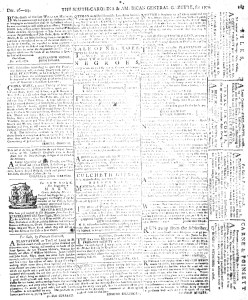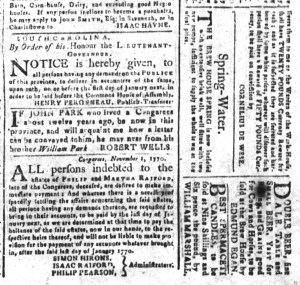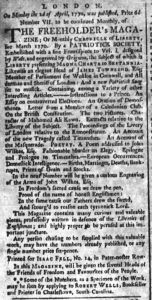What was advertised in a colonial American newspaper 250 years ago this week?

“The Public may be assured that THEIRS are the GENUINE.”
When Thomas Powell and Company published a midweek supplement, the South-Carolina Gazette Extraordinary on August 10, 1772, they proclaimed their intention to print both news and advertising as quickly as possible for the “ENTERTAINMENT” and “EMOLUMENT” of the public. Headers identifying “New Advertisements” appeared on three of the four pages of the supplement. Powell and Company placed one of their own advertisements immediately below one of those headers.
That advertisement continued a feud with Charles Crouch, printer of the South-Carolina Gazette and Country Journal, that the rivals pursued in advertisements in their newspapers throughout July. Powell and Company temporarily ceased participating at the time that Edward Hughes, one of the partners, died on July 30, but launched a new volley a short time later. Their desire to engage Crouch once again may have played a part in their decision to print a midweek supplement in early August.
The feud did not concern the printing trade or editorial policy. Instead, Crouch and Powell and Company squabbled over how best to market a patent medicine for venereal disease and which of them carried an authentic remedy. In a new advertisement in the midweek supplement, Powell and Company declared that they “lately received a Quantity of Dr. KEYSER’S GENUINE PILLS,” echoing the description most recently used by Crouch, “from Mr. James Rivington, Bookseller, in New-York, who is the ONLY Person that is appointed (by the Proprietor) for vending them in America.” That being the case, Powell and Company implied that Crouch sold counterfeit pills. “Therefore,” they proclaimed, “as the above T. POWELL, & Co. have always received the Pills sold by them from Mr. Rivington, the Public may be assured that THEIRS are the GENUINE.”
In a nota bene, Powell and Company referred readers to the third newspaper published in Charleston at the time, the South-Carolina and American General Gazette printed by Robert Wells. “For a surprising Cure performed by the Pills sold by Mr. Rivington,” Powell and Company instructed, “see Mr. WELLS’s Gazette, of August 3, 1772.” In what capacity did such an account appear in that newspaper? Was it part of an advertisement? If so, who placed it? Was it a puff piece that masqueraded as a news item? Did it direct readers to purchase the pills from a particular vender? Did Wells also sell the pills while managing to avoid a confrontation with Powell and Company? Or did Powell and Company intend for this advertisement to undermine both Crouch and Wells? Unfortunately, only scattered issues of the South-Carolina and American General Gazette from 1772 survive. Those issues have not been digitized for greater access. The combination of those factors prevent exploring what role Wells and his newspaper played in this controversy over marketing and selling patent medicines in Charleston in the summer of 1772.










